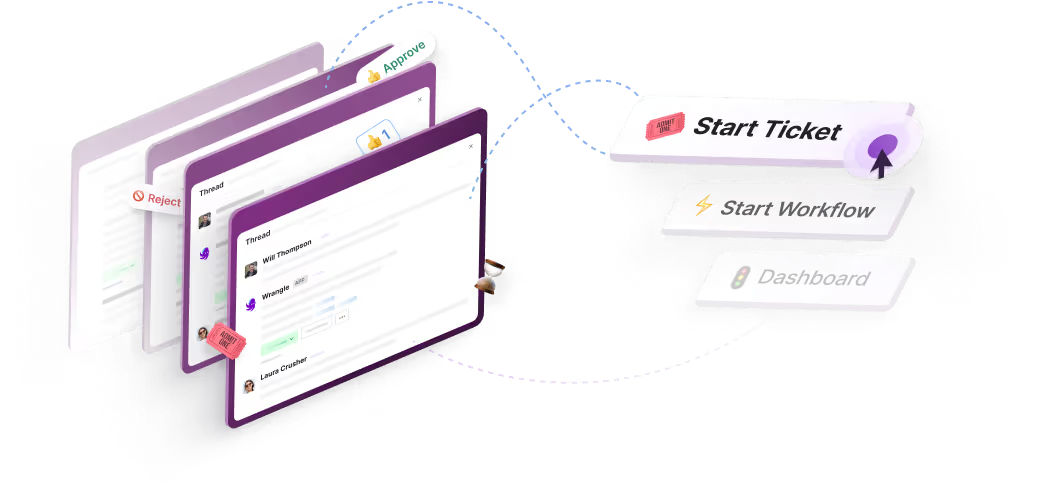How to Set Up and Improve Your Vendor Approval Process
The vendor approval process helps businesses grow. This article will discuss why companies require it, and what one looks like.


Companies today have an ever-growing amount of vendors and suppliers in their networks. It’s not uncommon for large organizations to have thousands of partners. For example, technology companies now have an average of 7,000 suppliers across the entire value chain. And aerospace and auto manufacturers work with an average of 12,000 and 18,000 suppliers, respectively.
As companies scale and expand their networks, approving vendors becomes increasingly important. After all, businesses need to have a robust vendor approval process in place to quickly vet vendors and keep workflows and pipelines moving.
Keep reading to learn what a vendor approval process is, why companies require it, and what one looks like. You’ll also learn how to set up a vendor approval process and some tips for enhancing it.
What Is Vendor Approval?
Vendor approval is a process for determining whether potential partners and suppliers are capable of meeting a company’s specific requirements.
Most companies today require vendors to gain approval before they conduct any work. Approval can apply to a broad range of categories, such as logistics, food services, IT support, and advertising, among others.
Why Do Companies Require Vendor Approvals?
Approval is a fundamental aspect of supplier management—and something that all companies should enforce. Here are some of the top reasons companies implement stringent vendor approval processes.
Ensure Security and Compliance
When you partner with a vendor, they often gain access to sensitive trade secrets. In addition, partnering with a third-party agency usually requires sharing network and data resources.
As a result, companies often need to assess the vendor and make sure they are up to date with the latest security safeguards and privacy frameworks like the EU’s General Data Protection Regulation.
When you partner with a vendor, they often gain access to sensitive trade secrets. In addition, partnering with a third-party agency usually requires sharing network and data resources.
Limit Spending
Requiring vendor approvals is also necessary for controlling spending. After all, companies have tight budgets and can’t afford to waste valuable resources. But this can be very difficult when there are multiple groups and individuals with spending power.
Running all vendor agreements through an approval process aligns different departments and helps prevent extraneous spending.
Maintain Quality Standards
A vendor ultimately becomes a direct extension of a company that it partners with. As such, it’s critical to make sure that a partnering agency shares the same values and quality standards.
Granting vendor approval signifies that a company agrees with the policies and procedures of the partnering agency and is willing to work directly with them.
The Main Components of a Vendor Approval Process
In some cases, vendor approvals can be very quick. For example, a director or manager may recommend a specific agency that they can vouch for and request an expedited approval process. But most of the time, companies have rigorous, multi-step approval processes employees need to follow when considering whether to work with third-party agencies.
With that in mind, here’s a general breakdown of what the vendor approval process entails.
Research Vendors
The process usually starts by researching vendors and collecting bids. At this point, the company may ask for RFPs or manually reach out to different companies and collect quotes.
Analyze Vendor Proposals
The next step is to collect and review different vendor proposals and shortlist providers based on whether they meet the company’s specific criteria.
Gain Internal Approval
After that, the procurement team will choose a target vendor and run the company through an internal vetting process. The level of approval typically depends on the size and structure of the organization and the nature of the service that the partnering vendor is going to provide.
Notify the Vendor
Once the internal team decides which vendor they want to work with, they then have to notify the partnering company, receive confirmation, and begin the onboarding process.
Process and Onboard the Vendor
The final step is to process the company and add them to the list of approved vendors. In some cases, approved vendors may go months or years without performing services. That being the case, it’s a good idea to periodically review the list of approved vendors and make sure that it’s up to date.
How to Set Up a Vendor Approval Process
It’s important to have a comprehensive framework in place when managing vendor approvals. This is necessary for efficiently processing approvals and preventing unnecessary delays.

You can use the following process as a template for setting up a vendor approval process.
1. Pick a Platform and Workflow
The platform you choose will play a major part in determining the overall efficiency, security, and reliability of your vendor approval process. Some companies opt to process requests via email, while others prefer to use purpose-built SaaS solutions. It’s also possible to automate approvals using a collaboration platform. Before you move forward, it’s helpful to round up your team and collect feedback on which platform they prefer using. Many companies use a tool like Wrangle that automates all of their vendor approval processes in Slack where employees can easily kickoff and manage requests.
2. Create an Approval Hierarchy
Once you pick a platform, you need to outline approval hierarchies for different types of vendors. For example, certain IT vendors may require approval from directors or CISOs. During this step, make sure you outline the approval hierarchies for quick and easy reference.
3. Set Your Criteria
The next step is to consult with department leaders and establish specific criteria for vendor approval. For example, vendors may need to demonstrate Service Organization Control 2 (SOC 2) to gain security clearance. And healthcare vendors will most likely need to demonstrate HIPAA compliance, regardless of the services they offer.
How to Improve Your Vendor Approval Process
As you build out your vendor approval process, keep the following tips in mind to build a resilient process that strengthens your organization.
Automate at Every Turn
As important as they are, vendor approvals can also be a huge pain for employees—especially for teams dealing with staffing shortages or those who need to quickly onboard vendors to complete projects. As a result, it’s important to leverage automation wherever possible. This saves time and also expedites vendor approvals.
As important as they are, vendor approvals can also be a huge pain for employees—especially for teams dealing with staffing shortages or those who need to quickly onboard vendors to complete projects.
Monitor and Optimize the Process
Vendor approval requirements may change over time. For example, companies may gain new security requirements or change their internal approval requirements. For this reason, you must monitor your vendor approval workflows and update them occasionally to reflect changing requirements.
Simplify the Process for Vendors
During the vendor approval process, the partnering organization is also assessing your business to see how it operates. As such, it’s critical to send the message that your business is committed to not only quality control but also to creating a vendor-friendly experience.
As a best practice, you should make the process simple and easy for the vendor to understand and execute. The vendor shouldn’t have a hard time moving through your approval form or understanding your documentation requirements.
Automate your Vendor Approval Processes in Slack
If your company uses Slack, you can build a seamless vendor approval process by adding a tool like Wrangle, a workflow automation application built for Slack. Wrangle allows you to build seamless workflows that are accessible in your Slack workspace. Your users can manage their entire vendor review process in an organized fashion in Slack.
Here’s how it works:
1. Install the the Wrangle app into your Slack workspace
2. Use Wrangle to create a vendor approval process workflow
3. Choose the Slack channel (or channels) where you’ll keep track of the process
4. Launch the workflow
5. Your users will be able to access the workflow directly in Slack


With the help of Wrangle, you can automate approval and ticketing workflows for all of your team members. The platform automatically assigns tasks and approvals and reduces issues like manual channel management and status tracking. You’ll also have access to reporting, analytics, and auditing.
Wrangle can automate any approval process, whether it’s your vendor reviews, budget approvals, expense management, IT ticketing, and more. If it’s a repeatable process, Wrangle can help you automate workflows in Slack.
To start automating your vendor approval process with Wrangle, add the tool to Slack today.
This post was written by Justin Reynolds. Justin is a freelance writer who enjoys telling stories about how technology, science, and creativity can help workers be more productive. In his spare time, he likes seeing or playing live music, hiking, and traveling.

- Try Wrangle free for 14 days
- Turn messages into trackable tickets
- Build a scalable help desk



Turn Slack into a productivity powerhouse with Wrangle
Create a scalable helpdesk in Slack. Automatically turn messages into trackable tickets and provide faster, more transparent service to your colleagues and customers with Wrangle — Try it free!






